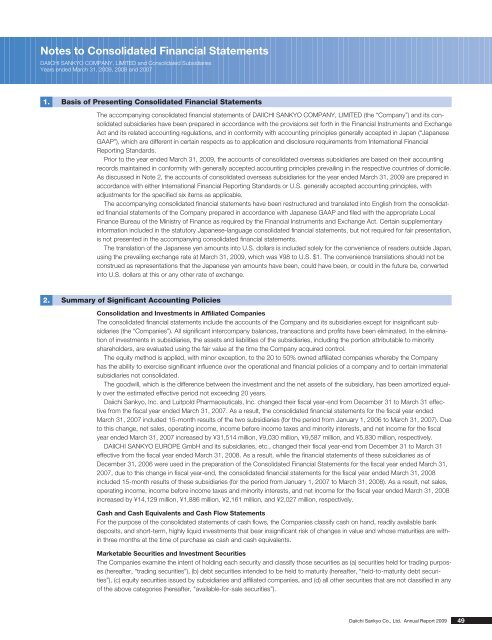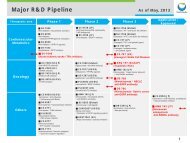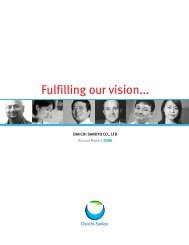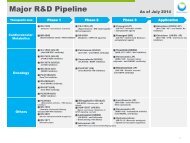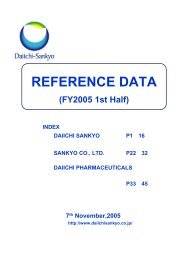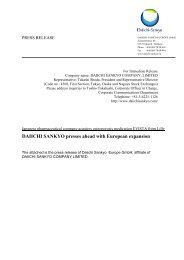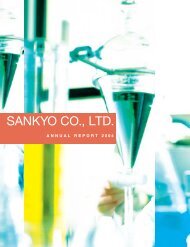Annual Report 2009 - Daiichi Sankyo
Annual Report 2009 - Daiichi Sankyo
Annual Report 2009 - Daiichi Sankyo
You also want an ePaper? Increase the reach of your titles
YUMPU automatically turns print PDFs into web optimized ePapers that Google loves.
Notes to Consolidated Financial Statements<br />
DAIICHI SANKYO COMPANY, LIMITED and Consolidated Subsidiaries<br />
Years ended March 31, <strong>2009</strong>, 2008 and 2007<br />
1.<br />
Basis of Presenting Consolidated Financial Statements<br />
The accompanying consolidated financial statements of DAIICHI SANKYO COMPANY, LIMITED (the “Company”) and its consolidated<br />
subsidiaries have been prepared in accordance with the provisions set forth in the Financial Instruments and Exchange<br />
Act and its related accounting regulations, and in conformity with accounting principles generally accepted in Japan (“Japanese<br />
GAAP”), which are different in certain respects as to application and disclosure requirements from International Financial<br />
<strong>Report</strong>ing Standards.<br />
Prior to the year ended March 31, <strong>2009</strong>, the accounts of consolidated overseas subsidiaries are based on their accounting<br />
records maintained in conformity with generally accepted accounting principles prevailing in the respective countries of domicile.<br />
As discussed in Note 2, the accounts of consolidated overseas subsidiaries for the year ended March 31, <strong>2009</strong> are prepared in<br />
accordance with either International Financial <strong>Report</strong>ing Standards or U.S. generally accepted accounting principles, with<br />
adjustments for the specified six items as applicable.<br />
The accompanying consolidated financial statements have been restructured and translated into English from the consolidated<br />
financial statements of the Company prepared in accordance with Japanese GAAP and filed with the appropriate Local<br />
Finance Bureau of the Ministry of Finance as required by the Financial Instruments and Exchange Act. Certain supplementary<br />
information included in the statutory Japanese-language consolidated financial statements, but not required for fair presentation,<br />
is not presented in the accompanying consolidated financial statements.<br />
The translation of the Japanese yen amounts into U.S. dollars is included solely for the convenience of readers outside Japan,<br />
using the prevailing exchange rate at March 31, <strong>2009</strong>, which was ¥98 to U.S. $1. The convenience translations should not be<br />
construed as representations that the Japanese yen amounts have been, could have been, or could in the future be, converted<br />
into U.S. dollars at this or any other rate of exchange.<br />
2.<br />
Summary of Significant Accounting Policies<br />
Consolidation and Investments in Affiliated Companies<br />
The consolidated financial statements include the accounts of the Company and its subsidiaries except for insignificant subsidiaries<br />
(the “Companies”). All significant intercompany balances, transactions and profits have been eliminated. In the elimination<br />
of investments in subsidiaries, the assets and liabilities of the subsidiaries, including the portion attributable to minority<br />
shareholders, are evaluated using the fair value at the time the Company acquired control.<br />
The equity method is applied, with minor exception, to the 20 to 50% owned affiliated companies whereby the Company<br />
has the ability to exercise significant influence over the operational and financial policies of a company and to certain immaterial<br />
subsidiaries not consolidated.<br />
The goodwill, which is the difference between the investment and the net assets of the subsidiary, has been amortized equally<br />
over the estimated effective period not exceeding 20 years.<br />
<strong>Daiichi</strong> <strong>Sankyo</strong>, Inc. and Luitpold Pharmaceuticals, Inc. changed their fiscal year-end from December 31 to March 31 effective<br />
from the fiscal year ended March 31, 2007. As a result, the consolidated financial statements for the fiscal year ended<br />
March 31, 2007 included 15-month results of the two subsidiaries (for the period from January 1, 2006 to March 31, 2007). Due<br />
to this change, net sales, operating income, income before income taxes and minority interests, and net income for the fiscal<br />
year ended March 31, 2007 increased by ¥31,514 million, ¥9,030 million, ¥9,587 million, and ¥5,830 million, respectively.<br />
DAIICHI SANKYO EUROPE GmbH and its subsidiaries, etc., changed their fiscal year-end from December 31 to March 31<br />
effective from the fiscal year ended March 31, 2008. As a result, while the financial statements of these subsidiaries as of<br />
December 31, 2006 were used in the preparation of the Consolidated Financial Statements for the fiscal year ended March 31,<br />
2007, due to this change in fiscal year-end, the consolidated financial statements for the fiscal year ended March 31, 2008<br />
included 15-month results of these subsidiaries (for the period from January 1, 2007 to March 31, 2008). As a result, net sales,<br />
operating income, income before income taxes and minority interests, and net income for the fiscal year ended March 31, 2008<br />
increased by ¥14,129 million, ¥1,886 million, ¥2,161 million, and ¥2,027 million, respectively.<br />
Cash and Cash Equivalents and Cash Flow Statements<br />
For the purpose of the consolidated statements of cash flows, the Companies classify cash on hand, readily available bank<br />
deposits, and short-term, highly liquid investments that bear insignificant risk of changes in value and whose maturities are within<br />
three months at the time of purchase as cash and cash equivalents.<br />
Marketable Securities and Investment Securities<br />
The Companies examine the intent of holding each security and classify those securities as (a) securities held for trading purposes<br />
(hereafter, “trading securities”), (b) debt securities intended to be held to maturity (hereafter, “held-to-maturity debt securities”),<br />
(c) equity securities issued by subsidiaries and affiliated companies, and (d) all other securities that are not classified in any<br />
of the above categories (hereafter, “available-for-sale securities”).<br />
<strong>Daiichi</strong> <strong>Sankyo</strong> Co., Ltd. <strong>Annual</strong> <strong>Report</strong> <strong>2009</strong> 49


